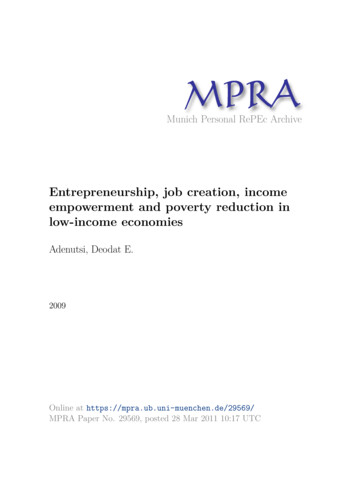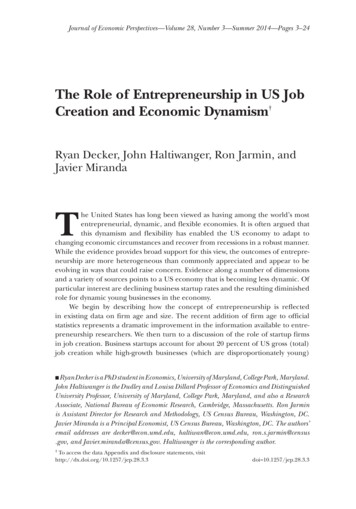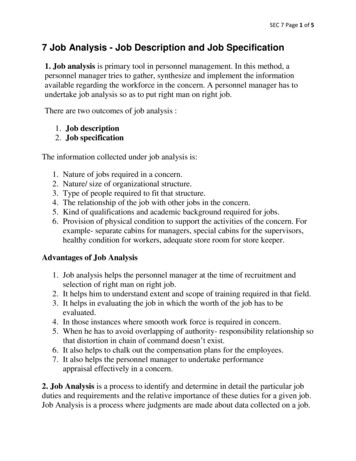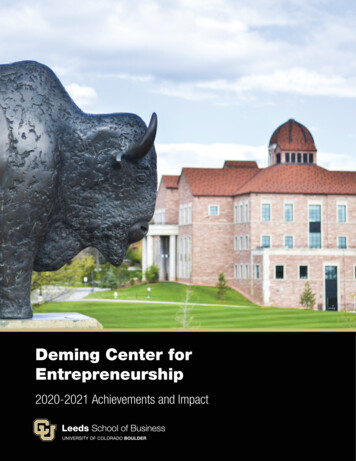
Transcription
Munich Personal RePEc ArchiveEntrepreneurship, job creation, incomeempowerment and poverty reduction inlow-income economiesAdenutsi, Deodat E.2009Online at https://mpra.ub.uni-muenchen.de/29569/MPRA Paper No. 29569, posted 28 Mar 2011 10:17 UTC
GLISTENGL I STEN Seminar PaperGSP/ 0 9 / 0 0 1E N T R E P R E N E U R S H I P , J O BC R E A T I O N , I N C O M EE M P O W E R M E N T A N DP O V E R T Y R E D U C T I O N I NL O W -I N C O M EE C O N O M I E SDEODAT EMI LSON ADENUTSIGLI STEN STRATEGI C SOLUTI ONS, ACCRA, GHANA
2 0 0 9 Glisten Str ategic SolutionsGSP/ 0 9 / 0 0 1www.glistenghana.comE N T R E P R E N E U R S H I P , J O BC R E A T I O N , I N C O M EE M P O W E R M E N T A N DP O V E R T Y R E D U C T I O N I NL O W -I N C O M EE C O N O M I E S1ByDEODAT EMI LSON ADENUTSI2Glisten S trategic S olutionsP ost Office Box M B 658A ccra, GhanaEmail: D eodat.Adenutsi@glistenghana.comstA Seminar Paper Pr esented at the Inaugur al/ 1 Induction Pr ogr amme of the Char ter ed Institute ofEconomists of Ghana, KORKDAM Hotel, Achimota, Accr a, Ghana on August 15 , 2 0 0 9This Seminar Paper should not be reported as representing the views of GLI STEN.The views expressed in this Seminar Paper are those of the author and do notnecessarily represent those of GLI STEN or its policy.1No part of this publication may be reproduced or distributed in any form or by any means, or stored in a database or retrieval system, without the prior written permission of GLISTEN.2The author is also a lecturer at the Department of Economics, Central University College, Accra, Ghana.1
ABSTRACTThe fundamental objective of this paper is to provide an insight into the role ofentrepreneurship in job creation, income generation and empowerment, and povertyreduction in low-income economies. Having provided a conceptual framework andthe theoretical underpinnings of the linkages of entrepreneurship to job creation,income empowerment and poverty reduction from an economic perspective, thepaper develops an entrepreneurial policy-relevant model for breaking the viciouscycle of poverty which has predominantly characterised low-income economies. Thepaper argues that entrepreneurship is the catalyst for economic growth anddevelopment through job creation, income empowerment and poverty reduction inan economy. However, to extend the culture of entrepreneurial thinking andpromote entrepreneurship in an economy, it is imperative for governments and otherrelevant institutions to pursue functional policy goals in this endeavour. Therefore, inorder to create high-income generating jobs opportunities and reduce povertythrough entrepreneurship, there is the need for policy measures and interventionprogrammes that are critical and consistent with the objective of welfareimprovements.Keyw ords: Entrepreneurship, Job Creation, Poverty, Low-I ncome Economies2
1.0 I NTRODUCTI ONLow-income countries are generally poor because of low productivity and overdependency on the primary sector where value addition is at the ebb. This lowproductivity culminates in low real per capita income, low consumption of essentiallife-sustaining commodities, low savings, and low capital formation. I nvariably, thissituation lends credence to the popularly known “vicious cycle of poverty hypothesis”which underlies the perpetuation of underdevelopment of these economies of whichSub-Saharan Africa, Latin America, the Caribbean and South-East Asia havedominated since human civilisation. The irony of the issue is that these features oflow-income countries have been prevalent in spite of the abundant human andnatural resources available to these economies.As far back as 1776, Adam Smith identified the significant roles markets can play inthe economic growth and development process of nations through job creation,higher incomes and increased access to basic human needs. Over the past twocenturies, evidences have shown the remarkable ability of capitalist-orientedeconomies to spontaneously increase living standards dramatically from thesubsistence survival on the margin to the affluence of modern living lifestyles. Thus,economies which have limited scope of market freedom have generally beenunderdeveloped systematically. To a very large extent, this has justified thesignificance of the famous expression “the invincible hand” Smith spoke about in1776.As the world economy is now driven by market processes and entrepreneurialactivities than ever before in human history, policymakers and development expertshave, by default behaviour, reached an unmistakable consensus that the role ofentrepreneurship in job creation, income generation and poverty reduction can nolonger be downplayed. The relevant empirical evidences are not farfetched.Countries with vibrant private sector participation and large capitalist class such asthe United States of America, the United Kingdom, Germany, Japan, Canada, Franceand those from the Nordic and Scandinavian regions are more developed than those3
from Latin America and the Caribbean, Sub-Saharan Africa, and South East Asia,which have relatively small capitalist class and hence poor entrepreneurialperformance. Quite clearly, the outcome of an entrepreneurial activity should, asexpected, have straightforward policy implications forjob creation,incomeempowerment, and poverty reduction efforts of a low-income economy. Forinstance, in today’s world, the formulation of an economic policy aimed at jobcreation, sustainable income generation and poverty alleviation, which does notrecognise and incorporate entrepreneurship, is most likely to fail. I ndeed, such aneconomic policy may, in itself, be an instrument for retarding economic progress andprosperity.Given the foregoing, this paper generally seeks to provide an insight into hroughwhichentrepreneurship can lead to job creation, income empowerment and povertyreduction in a typical low-income economy. I n particular, the paper attempts totheoretically formulate a model for job creation, income empowerment and povertyreduction for low-income countries from the pursuit of strategic economic policies onthe development of entrepreneurship.The next section of the paper discusses the conceptual framework and thetheoretical underpinnings of entrepreneurship, job creation, income empowermentandpoverty.This sectionalso highlights onthe broadessential role ofentrepreneurship in economic growth and development process. I n Section 3,empirical literature was reviewed. The profiles of the world’s richest people ofAmerican descent were also provided under this section. Section 4 discusses theanalytical foundation and proposes an empirical model for job creation, incomeempowerment and poverty reduction via ent repreneurship. I n section 5, the paperconcludes with some policy prescriptions.4
2.0 CONCEPTUAL FRAMEWORK AND THEORETI CAL UNDERPI NNI NGSI t is not too much surprising that in many societies today, poverty abounds and,indeed, has been pervasive amidst abundant economic resources. This is becausethe concepts of entrepreneurship and poverty have been particularly difficult todefine and, widely misunderstood by many, including institutions responsible forpolicymaking and implementation.2.1 Definition of ConceptsWithin the context of this study, entrepreneurship is defined as the identification ofbusiness opportunities and the mobilisation of economic resources to initiate a newbusiness or revitalise an existing business, under the conditions of risks anduncertainties, for the purpose of making profits under private ownership. I n simpleterms, entrepreneurship is the unique profit-driven productive ideas and pragmaticefforts which make the combination of scarce resources possible under privateownership. An entrepreneurial activity is a skilful profit-oriented and self-involvingundertaking aimed at creating value through modernisation of production processesor the identification and exploitation of new markets or products. Therefore, anysmall and medium scale business, in which the owner has some role to play, notnecessarily by fully managing the day-to-day activities of the enterprise, may beconsidered an entrepreneurial initiative.Poverty is a state of absolute economic deprivation in which the individual cannotindependently have access to the basic human life-sustaining essentials such asfood, clothing, protection, and shelter. Job creation is the income-earningopportunity offered to other people, consciously or unconsciously, in the course ofseeking one’s own economic interest for initiating an entrepreneurial activity. Jobcreation from an entrepreneurial activity could be direct (in which case theentrepreneur personally employs other persons into his/ her firm), or indirect (whenincome-earning opportunities are created for other entrepreneurs to emerge to offersubsidiary products/ services).5
I ncome empowerment is the self-confidence, self-esteem and freedom fromservitude associated with the earning or the assurance of earning regular income forundertaking a lawful economic activity, which will enable the income earner live atleast a decent normal life. An individual who has been empowered by income shouldbe in the position of taking independent decisions regarding his/ her life and beresponsible for taking these decisions.2.2 The Essential Role of Entrepreneurship in Economic Grow th andDevelopment ProcessI n this modern world of globalisation when market-based economic system dominateeconomic thinking and policy formulation, ent repreneurship and the development ofproductive capacities within the private sector have become indispensable toushering countries into the global trading and development network. I n this regard,the benefits of entrepreneurship to an economy in the 21st century cannot beunderestimated.2.2.1 The Benefits of neurshipcanveryenormous.Entrepreneurship is about making differences in business as entrepreneurs wouldonly initiate a business if they are convinced that they have what it takes to seize anopportunity to make a difference in a cause that is vital to their personal andprofessional ambit ions. With this in mind, entrepreneurship is essentially aboutstriving to earn a good living as entrepreneurs are often rewarded with substantialfinancial gain in the form of profits. Another enviable benefit of entrepreneurship isself-employment and own-bossing, which often offer unlimited job satisfaction andflexibility. Entrepreneurship also creates jobs3 for others and hence could reduce therate emigration and unemployment in an economy. Entrepreneurship is a source ofincome generation which propels economic growth. As entrepreneurs are highlymotivated to be competitive and desirous of reaching their full potentials because3Jobs are created directly and indirectly through the chain of interrelated value-addition processes within andoutside the enterprise. It is common to find positive spill over effects with regard to job creation.6
the business is taken as the medium for self-expression and self-actualisation, theproduction of higher quality goods and services are guaranteed. I n this respect, theentrepreneur knows no boundaries as far as business success is concerned becausehis/ her creativity, enthusiasm and vision are limitless. Entrepreneurship also has thepotential of enhancing the development of new markets as well as the developmentof entrepreneurial qualities and attitudes among potential entrepreneurs to bringabout significant improvements in societies.Furthermore, entrepreneurship is the key to the growth and development of localindustries through the processing of local raw materials into finished and semifinished goods for the domestic and foreign markets. I t also promotes the utilisationof improved and cost-effective technology in small and medium-scale enterpriseswhich enhances higher factor productivity at the local level especially in low-incomecountries where the traditional rural economy is predominant.2.2.2 The Costs of EntrepreneurshipI n spite of the numerous advantages associated with entrepreneurship, there arestill some costs that are connected with the profession apparently becauseentrepreneurship is usually a difficult undertaking with a relatively high failure rate.Some of the potential drawbacks associated with pursuing entrepreneurial venturesinclude uncertainty of the flow and size of income, working hard for long hourswhich could even be more than 60 hours per week4, and the risk of losing one’sentire investment. All these impose a considerable stress on the entrepreneur.The advantages and disadvantages of entrepreneurship notwithstanding, a rationalindividual would choose to participate in an economic activity such as becoming anentrepreneur provided he/ she can be certain that the utility of participation exceedsthe utility of non-participation. As far as private entrepreneurship is concerned, thepursuit of an entrepreneurial venture is also determined by whether or not, the4A survey by Dun and Bradstreet (2002) on small-scale business owners shows that 17% strictly devoted at least 60 hours aweek to their businesses. Again, about 50% of these entrepreneurs spend between 41 and 60 hours a week on theirbusinesses.7
individual is oriented towards opportunity-driven entrepreneurship or survival-drivenentrepreneurship, which is further, determined by the socioeconomic status of theindividual in context as well as his/ her entrepreneurial capabilities.2.3 Entrepreneurship, Employment, I ncome and Poverty: The TheoreticalNexusThe linkages of entrepreneurship with employment, income, poverty are quite simpleand straightforward. Development economists are of the opinion that economicgrowth is a necessary pre-condition for poverty reduction, and arguably the singlemost important factor influencing poverty. This view seems to have enjoyedtremendous universal empirical support as historically there has been a strongnegative correlat ion between per capita income and poverty indicators. Meanwhile,models of economic growth and development have been very consistent in assertingthat economic growth is driven primarily by private sector capital accumulation, andhence the economic objective of any modern economy is to promote the conditionsthat facilitate private sector investment by way of strengthening and motivating thesociety to develop their entrepreneurial potentials to the fullest.2.3.1 Entrepreneurship and Job CreationI n an entrepreneurial society, job creation is a common feature as new actors in theeconomy have new characterist ics through open-source culture. Such a societybreeds a strong network of angel investors and training activities for the futureventure capitalists and corporate leaders. Besides, entrepreneurial activity is alwaysabout value creation. Value creation enhances factor productivity which promotesfactor utilisation and intensity in a typical production process. Consequently, jobs arecreated within and outside a particular enterprise from any entrepreneurial activity.Entrepreneurship increases access to economic opportunities by providing usefulinformation on manpower training and skills development, access to capital andbusiness development. Through increased knowledge, entrepreneurs are able tobecome more competitive in the market. Accordingly, entrepreneurship creates jobs8
through forward and backward linkages. I n a vibrant economy, the development ofentrepreneurship breeds the emergence of ancillary enterprises which supply rawmaterials including energy and related industrial services such as packaging,advertising, insurance, banking and finance including microfinance, transport andcommunication. At the same time, some entrepreneurs may emerge to add value tothe bye-products generated by the parent firm.2.3.2 Entrepreneurship, I ncome Empowerment and Poverty ReductionEntrepreneurship is very rarely a get-rich-quick business undertaking similar togambling. Rather, the concept is, in fact, concerned with creating long-term valueand consistent cash flow streams for the future through the power of imagination,initiative and innovation. The long-term value creation focus of entrepreneurshiprequires that the entrepreneur strategizes towards maximizing profits and long-runexpansion. Enterprise growth is directly associat ed with increased demand forproductive resources including labour and the payment of realistic and competitiverewards to attract and retain these factor inputs to lend their services to theentrepreneur. I n this context, entrepreneurship offers a reliable source of incomeearning, not only to the entrepreneur and labour, but other factor inputs. Given thelong-term focus and the growth potential of entrepreneurial activities, theentrepreneur and labour, and indeed, all income earners from entrepreneurialactivities, become more economically independent and confident to confront thechallenges of life. I t can, therefore, be st ated that entrepreneurship promotesincome empowerment in an economy. I n the modern world, entrepreneurshipprovides a new approach for fighting poverty and stimulating economic growth indeveloping countries. Entrepreneurship, to a very large extent, narrows the incomegap and delivers a consistent mechanism for earning incomes and thereby reducingincome inequality and poverty substantially.I n practice, entrepreneurship is directly linked to higher productivity. The incentivefor higher factor productivity is higher income. I n order to sustain higher factorproductivity to achieve the long-run growth objective of an enterprise, the9
entrepreneur must be committed to paying higher incomes in real terms. As theentrepreneur and labour keep enjoying higher incomes in real terms, they arenaturally empowered economically through incomes, which push them above thepoverty-line more permanently.2.4 Entrepreneurship as a Tool for Breaking the Poverty ChainUntil a favourable external shock intervenes to break the cycle of poverty, the verypoor of the society are very likely to remain poor forever. This scenario is illustratedin Figure 1 below.2.4.1 The Vicious Cycle of PovertyFigure 1 : The Vicious Cycle of PovertySource : Author’s impressionFrom Figure 1 above, poverty is arising from low productivity as households facefinancial constraints and lack the other incentives of entrepreneurship. Low factorproductivity is the reason for earning low income which does not empower thehousehold to purchase sufficient basic life-sustaining goods and services despite the10
fact that the marginal propensity of consume is one or approximately one. The highpropensities to consume have left the household with nothing or very little to saveand accumulate capital for investment. The inability of a household to invest impliesthat the income of this household would remain low in the future and theirproductive resources will continue to be underemployed or unemployed. Thissuggests that the vicious cycle of poverty is set in motion. The only way out of thischain of apparent poverty perpetuity is access to essential external resources forboosting productivity which can result in improved household incomes abovesubsistence levels for surpluses to be generated for investment purposes.The presence of entrepreneurial capability in a household and the accessibility ofbasic infrastructure facilitating easy entrepreneurship are the two main factorsmotivating a household to pursue entrepreneurial activities. I deally, these pushfactors must be reinforced by conscious policy actions to boost demand for thegoods and services produced by the entrepreneur within the economy.2.5 The Entrepreneurial ProcessI n a typical market-based economy, an entrepreneurial process takes the form of aprofitable idea which commences with the identification and evaluation of a marketfor a product or a service as well as the resources required to systemat ically create anew finished product/ service to meet the needs of mankind. Economic resources areacquired and a value is created from these resources at a certain cost. The endproduct is sold at a price higher than the sum of manufacturing and distribution ofthe product into physically different products in an innovative and profitable manner.For entrepreneurs in a distribution chain, the process commences with theidentification of markets with prices for the same product varying across them. Theentrepreneur focuses on buying from a lowly-priced market and selling in a highlypriced market for profits in excess of purchases and cost of sales including the costof transportation, handling and distribution.11
Accordingly, entrepreneurial process begins with good business idea formulation. Abusiness good idea could be the realisation that a new distribution point at a specificlocation could be a profitable business undertaking. I t must be noted that anentrepreneurial activity involves the application of new knowledge through asystematic research which culminates in acquiring resources and application of costefficient production techniques. By implication, a good business idea in a form ofnew knowledge must have a commercial value so that this idea can be useful increating a product/ service which is physically different from the resources used toproduce them.3.0 EMPI RI CAL LI TERATURE REVI EWEmpirical studies have shown that owners of SMEs are content with theirindependence which motivates them to be diligent and generate personal incomerather than being an employee for someone else. The Gallup Organisation (2007),for instance, found that over 85 percent of owners of SMEs were delighted to haveowned their own enterprises than working for another person.The influx of entrepreneurial activities has contributed to the springing up ofancillary institutions such as microfinance institutions in recent years. owsthat,indirectly,entrepreneurship is the key to poverty reduction not just for the beneficiaries, butalso there with positive externalities to the rest of the society. Coleman (2006) andHulme (1999), however, argue that the ability of microcredit facilities to eradicatepoverty is dependent upon the socioeconomic environment of the household incontext. What appears evident is that the application of finance to entrepreneurialactivities is a more permanent and reliable way of eradicating poverty in aneconomy.12
3.1 Evidence of Positive Correlation betw een Entrepreneurship and WealthTable 1 : The Profile of the World's Richest People from the American EconomyName of EntrepreneurProfile of EntrepreneurStephen Girard(1750-1831)Largest investor in the First Bank of theUSA. Loaned the US Treasury US 8million to finance the War of 1812A German-born immigrant who began asa fur trader.Borrowed US 100 from his mother atage 12 to start what became the StateI sland FerryFounded the premier Department Storein the USA.Took advantage of a sudden increase indemand for lumber to become rich.Started as a bobbin boy but became thefounder of the US Steel.FirstAmericanbillionaire.CreatedAmerica's most powerful monopoly, theStandard OilCompanyLaunched Wal-Mart near his hometownof Bentonville, Arkansas, and developedit intothe largest company in the worldStarted Oracle Corporation with US 2000of his own money. Now the secondlargestmaker of computers behind Microsoft.Dropped out of Harvard and launchedMicrosoft Corporation with a colleague,Paul Allen. The wealthiest Americantoday.Started Dell Computer from his dormitoryroom at the University of Texas. Salesnowexceed US 70 billion a yearJohn Jacob Astor(1763-1848)Cornelius Vanderbilt(1794-1877)Alexander T. Andrew Carnegie(1835-1919)John D. Rockefeller(1839-1937)Sam Walton(1918-1992)Larry Ellison(1944 -)Bill Gates(1955 -)Michael Dell(1965-)Type ofBusinessShipping /BankingReal EstateRailroad eComputerSoftwareComputers* Computed by dividing entrepreneur's total wealth by t he US GDP at the time of Death, or if person is still living, by 2001GDP. Source : Aut hor’s compilation from "The World's Richest People," Forbes’ websit e, July, 2009.I n Table 1 above, it is shown that entrepreneurship is synonymous with wealthacquisition. Taking the American economy as a case study, there is a positivecorrelation between entrepreneurship and wealth. I ndeed, all over the world, therichest persons have been entrepreneurs. Examples abound in every community andeconomy irrespective of the level of development. For instance, in Ghana and13
Nigeria, the richest people of all-time have been entrepreneurs who own fleets ofmarine vessels, aircrafts, schools, oil marketing companies, hotels, commercialfarms, retail and departmental shops, telecommunication companies, advertisingcompanies, insurance and finance companies, or either engage in extensive importor export business, or manufacture/ assemble automobiles or computers. This is aclear testimony to the fact that entrepreneurship is the single most important meansto create jobs empower people through increased income, and reduce poverty in aneconomy.4.0 THE ANALYTI CAL FOUNDATI ON AND THE EMPI RI CAL MODEL4.1 The Analytical Foundation4.1.1 The Entrepreneurship Channel to Job Creation, I ncome Empowerment andPoverty Reduction in Low-I ncome EconomiesI n Figure 2 below, an attempt is made to explain how entrepreneurship can be usedto create jobs, generate income and reduce poverty in a low-income economy.Figure 2: A Framework of an Entrepreneurial Approach to Job Creation, I ncomeGeneration and Poverty Reduction in an EconomySource : Author’s own formulationTable 2 belowentrepreneurship,summarizes the main components ofentrepreneurialactivities,the determinants ofentrepreneurialperformanceandsocioeconomic impact of entrepreneurship as elements of an entrepreneurial processrelevant to job creat ion, income generation and empowerment, and povertyreduction on a typical economy. Access to capital, attitudes and investment culture,14
research and development (R&D) and technology, quality of entrepreneurialresources, economic environment, legal and regulatory framework and governmentpolicy are the essential factors influencing the development of entrepreneurship inan economy. Entrepreneurial activit ies include the identification/ creat ion of businessopportunities,evaluationofbusinessideas/ opportunities,businessplanning,mobilisation of requisite resources, self-involvement/ self-employmentsuch asmanagement of the enterprise, and combination of the resources through innovativepractices and value-addition.Table 2: Elements of Entrepreneurial Approach in Job Creation, I ncome Empowerment andPoverty ReductionDeterminants eneurial SocioeconomicPerformanceI mpactAccess to AdequateFinanceCulture and AttitudesI dentification/ Creationof OpportunitiesFormulation ofBusiness I deasBusiness PlanDevelopmentResource MobilisationSurvival Rate ofStart-upsGrowth ofEnterprisesLabour ForceJob Creation/ Rate &Size of EmploymentI ncome GenerationPenetration ofExport MarketsTurnover/ MarketDominanceProfit MarginsSaving & I nvestmentRatesPoverty ReductionTax and OtherStatutoryComplianceI nfrastructure/ CorporateSocial ResponsibilityEntrepreneurialResourcesR&D and TechnologyEconomicEnvironmentLegal and RegulatoryFrameworkGovernment PolicyValue-AdditionActivitiesI nnovative PracticesSelf-EmploymentConsumptionEconomic Growth RateSource : Author’s own compilationWith regard to the performance of an entrepreneurial accomplishment, the survivalrate of the enterprise, growth of the enterprise, labour force, turnover and domesticmarket dominance, penetration of external markets, profit margins, and tax andother statutory compliance are the key issues involved. I n examining thesocioeconomic impact of entrepreneurship in an economy, the critical factors oftentaken into account include job creation, income status of employees and theentrepreneur, level of consumption, rate of saving and investment, overall reduction15
in poverty levels of employees and the ent repreneur, contribution to the growthprocess of the economy as well as the direct contribution to infrastructuraldevelopment through corporate social responsibility.4.2 A Model for Poverty Reduction via Entrepreneurship in Low- I ncomeEconomiesI n the proposed model for job creation, income empowerment, and povertyreduction in low-income economies suggested in Figure 3 below, the government orthe appropriate institution is expected to identify and deliver the influential factor ofentrepreneurship inhibiting entrepreneurial initiatives within a typical household oran economy. The supply of this factor to the household/ economy should to beadequate enough to support the beneficiary to sustain the entrepreneurial venture.16
Figure 3 : A Model of an Entrepreneurial Approach to Poverty ReductionSource : Author’s own formulationEven though, in general, the availability and easy access to any of the essentialdeterminants of entrepreneurship through a policy intervention would be thebeginning of breaking the poverty cycle, in low-income countries, financial17
constraints – lack of adequate equity capital and high cost of borrowing arising fromexcess demand for investible funds – are probably the most prominent barrier forgrowth and development of entrepreneurship. I t is, thus, believed that holding allother factors constant, a policy intervention by way of making investible fundsavailable to potential entrepreneurs would go a long way in creating jobopportunities, raising incomes, and reducing the high incidence of poverty in lowincome economies.The underlying assumptions for the formulation of the model include:i.The poor of the society are aware of their socioeconomic conditions and areprepared to w
paper develops an entrepreneurial policy-relevant model for breaking the vicious cycle of poverty which has predominantly characterised low-income economies. . Income empowerment is the self-confidence, self-esteem and freedom from . Jobs are created directly and indirectly through the chain










